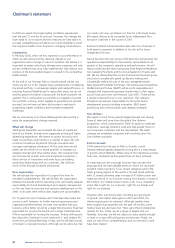Unilever 2004 Annual Report Download - page 21
Download and view the complete annual report
Please find page 21 of the 2004 Unilever annual report below. You can navigate through the pages in the report by either clicking on the pages listed below, or by using the keyword search tool below to find specific information within the annual report.18 Unilever Annual Report and Accounts 2004
Financial review
(continued)
Impairment reviews are performed following the guidance in UK
Financial Reporting Standard 11, United States SFAS 142 and
SFAS 144. Such reviews are performed by comparing the carrying
value of the asset concerned to a valuation derived from
discounted future cash flows. Significant assumptions, such as
long-term growth rates and discount rates, are made in preparing
these forecast cash flows; although these are believed to be
appropriate, changes in these assumptions could change the
outcomes of the impairment reviews.
The most significant balances of goodwill and intangible assets
are those arising from the purchases of Bestfoods and Slim•Fast.
We have reviewed the balances related to the Bestfoods
acquisition (€13.3 billion), by considering actual and planned
growth rates of Bestfoods brands and the synergy savings arising
from its integration. No impairment loss has been identified.
We have also reviewed the balances related to Slim•Fast in light of
the significant decline in the weight-management category in
North America that took place during the second half of 2004.
This is expected to continue to impact market volumes in 2005.
The results of the review indicated that a goodwill impairment
charge of €591 million was necessary. Our assessment is based on
a number of important assumptions regarding the future
performance of the Slim•Fast business. In particular, the business
is assumed to return to growth by 2007, and thereafter to
achieve levels of growth and margin that are consistent with
typical North American foods businesses. The review was based
on a 10 year discounted cash flow methodology using a pre-tax
discount rate of 11%.
Deferred tax
Full provision is made for deferred taxation, as required under UK
Financial Reporting Standard 19, at the rates of tax prevailing at
the year end unless future rates have been enacted, as detailed
on page 97. Deferred tax assets are regularly reviewed for
recoverability, and a valuation allowance is established to the
extent that recoverability is not considered likely.
International Financial Reporting Standards
Unilever is adopting International Financial Reporting Standards
(IFRS) with effect from 1 January 2005. In 2004 we substantially
completed our assessment of the impact of the change to IFRS on
our reported capital and reserves and on reported profit. We have
also completed the modification of our accounting and reporting
systems to facilitate the changes and we have designed and run
an IFRS training programme for those employees that are affected
by the changes.
The most important changes to our accounting policies are listed
below. These changes will also affect the 2004 comparative
information in the 2005 consolidated financial statements with
the exception of the changes in accounting for financial
instruments and the presentation of assets held for sale, which
will be applied prospectively from 1 January 2005.
Under IFRS 3, from 1 January 2004 we will no longer apply
systematic amortisation to goodwill and intangible assets with an
indefinite life, but will instead test these assets for impairment on
at least an annual basis. The amortisation charge for all goodwill
and indefinite lived intangible assets in 2004 was €1 040 million.
Under IAS 10 we will no longer recognise a liability in any period
for dividends which have been proposed but will not be approved
until after the balance sheet date. The proposed final dividends
for 2004 amount to €1.26 per €0.51 ordinary NV share and
12.82p per 1.4p ordinary PLC share, a total liability of €1 215
million.
Under IAS 12 we will recognise certain additional deferred tax
balances arising on temporary differences between the tax base
and the accounting base of balance sheet items. The most
significant of these relates to intangible assets which were
identified at the time of the Bestfoods acquisition, on which a
deferred tax liability will be established via reserves.
Under IAS 38 we will capitalise and amortise purchased and
internally developed software. The value of purchased and
internally developed software as at 31 December 2004 amounted
to €166 million.
From 1 January 2005 onwards we will present NV preference
share capital as a liability rather than as a part of capital and
reserves, in accordance with IAS 32. The carrying value of these
preference shares as at 31 December 2004 was €1 502 million.
Also from this date we will recognise all derivative financial
instruments on balance sheet and will measure certain non-
derivative financial assets at fair value with unrealised movements
in fair value recognised directly within equity.
Other areas where our current accounting policies differ from
IFRS and will therefore change include retirement benefits and
biological assets (tea bushes and oil palm trees). In the case of
retirement benefits, the recent amendments to IAS 19 mean that
the impact on Unilever will be restricted to certain valuation
differences which are not expected to have a significant impact
on our reported numbers.
For further details of these and other reporting changes which
may apply for 2005, please refer to our website at
www.unilever.com/ourcompany/investorcentre/.
























